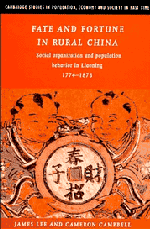Book contents
- Frontmatter
- Contents
- List of figures
- List of maps
- List of tables
- Acknowledgements
- PART 1 DAOYI VILLAGE
- PART 2 THE LIAONING DEMOGRAPHIC SYSTEM
- PART 3 HOUSEHOLD ORGANIZATION AND POPULATION BEHAVIOR
- PART 4 BANNER ORGANIZATION AND POPULATION BEHAVIOR
- 8 Bannermen and banner organization
- 9 Banner hierarchy and demographic privilege
- 10 Two types of social mobility
- EPILOGUE: PROSPECTS, IMPLICATIONS, AND COMPARISONS
- Appendices
- Glossary
- References
- Index
- Cambridge Studies in Population, Economy and Society in Past Time
9 - Banner hierarchy and demographic privilege
Published online by Cambridge University Press: 20 October 2009
- Frontmatter
- Contents
- List of figures
- List of maps
- List of tables
- Acknowledgements
- PART 1 DAOYI VILLAGE
- PART 2 THE LIAONING DEMOGRAPHIC SYSTEM
- PART 3 HOUSEHOLD ORGANIZATION AND POPULATION BEHAVIOR
- PART 4 BANNER ORGANIZATION AND POPULATION BEHAVIOR
- 8 Bannermen and banner organization
- 9 Banner hierarchy and demographic privilege
- 10 Two types of social mobility
- EPILOGUE: PROSPECTS, IMPLICATIONS, AND COMPARISONS
- Appendices
- Glossary
- References
- Index
- Cambridge Studies in Population, Economy and Society in Past Time
Summary
In Daoyi, all together 1,400 men rose in the banner hierarchy: 400 in the occupational hierarchy and 1000 in the organizational hierarchy. These men in theory were the elite of rural banner society. They were assumed to be the most capable. They were stipulated to be the best paid. And they were supposed to be the most powerful. If they were as privileged in fact as they were in theory, this should be apparent in their demographic behavior. We have already seen in Chapter 7 how marriage, fertility, and even mortality were related to position in the domestic hierarchy. In this chapter we explore how they were also related to position in the banner hierarchies.
We divide our chapter into two sections, each with its own methodology. In section I, we follow the arithmetic methodology used in Chapter 7 to analyze the distribution of privilege within the household, calculating measures of demographic performance—the proportion married, and the number and sex ratio of children “born”—according to the various categories of banner service. In section II, we introduce logistic regression to compare the effects of position in the banner and household hierarchies on demographic behavior and determine their relative importance.
In so doing, we differentiate not only the degree of demographic privilege enjoyed by the household and banner hierarchies over ordinary men, but also the degree of privilege within these hierarchies. Thus we see whether artisans were above soldiers, and whether civil officials were on equal footing with military officials. While we have a clear understanding of the normative ordering of position within the household, our knowledge of the banner hierarchy is much less complete.
- Type
- Chapter
- Information
- Fate and Fortune in Rural ChinaSocial Organization and Population Behavior in Liaoning 1774–1873, pp. 177 - 195Publisher: Cambridge University PressPrint publication year: 1997



